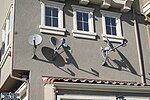Satellite dish



A satellite dish is a type of parabolic antenna designed with the specific purpose of transmitting signals to and/or receiving from satellites. A satellite dish is a particular type of microwave antenna. Satellite dishes come in varying sizes and designs, and are most commonly used to receive satellite television.
The parabolic shape of a dish reflects the signal to the dish’s focal point. Mounted on brackets at the dish's focal point is a device called a feedhorn. This feedhorn is essentially the front-end of a waveguide that gathers the signals at or near the focal point and 'conducts' them to a low-noise block downconverter or LNB. The LNB converts the signals from electromagnetic or radio waves to electrical signals and shifts the signals from the downlinked C-band and/or Ku-band to the L-band range. Direct broadcast satellite dishes use an LNBF, which integrates the feedhorn with the LNB. (A new form of omnidirectional satellite antenna, which does not use a directed parabolic dish and can be used on a mobile platform such as a vehicle was announced by the University of Waterloo. [1])
Modern dishes intended for home television use are generally 43 cm (18") to 80 cm (31") in diameter, and are fixed in one position, for Ku-band reception from one orbital position. Prior to the existence of Direct broadcast satellite services, home users would generally have a motorised C-band satellite dish of up to 3 metres in diameter for reception of channels from different satellites. Overly small dishes can still cause problems, however, including rain fade and interference from adjacent satellites.
Motorised satellite dishes are still popular with enthusiasts, and three competing standards, which are often all supported by a set-top box, DiSEqC, USALS, and 36v Positioners.
A common misconception is that the LNBF (low-noise block/feedhorn), the device at the front of the dish, receives the signal directly from the atmosphere. See, for instance, this BBC News 24 [2] countdown that shows a "red data stream" being received by the LNBF directly instead of being beamed to the dish, which because of its parabolic shape will collect the signal into a smaller area and deliver it to the LNBF.
In Europe the frequencies used by DBS services are 10.7 - 12.75 GHz on two polarizations H and V. This represents a total of 4.1 GHz of spectral bandwidth which is split into 4 polarization/frequency bands. On the coaxial cable between the LNBF and the receiver frequencies 950 - 2150 MHz are allocated for the satellite service. Lower frequencies are allocated to Cable and Terrestrial TV, FM radio, etc. There are 4 bands - Vertical High, Vertical Low, Horizontal High and Horizontal Low, each of these bands needs a separate cable from the LNBF to the receiver or the receiver needs to select one of the 4 bands at a time.
In a single receiver residential installation there is a single cable and the receiver uses different power supply voltages and pilot tones to instruct the LNB to select one of the 4 bands. In a larger installation each band is given its own cable and there are 4 cables from the LNB to a switching matrix, which allows the connection of multiple receivers in a star topology using the same signalling method as in a single receiver installation.
The quality of a satellite dish is usually expressed as a G/T ratio. This is the "gain" (I.E.: signal amplification) of the dish divided by the amount of noise the LNB produces. The gain depends on many factors including surface finish, accuracy of shape, feedhorn masking, and size (the bigger the dish the better). The amount of noise an LNB produces depends on design, temperature, and losses in the cables.
Types
- Individual dishes serving one dwelling: Direct To Home (DTH).
- Collective dishes, shared by several dwellings: Satellite Master Antenna Television (SMATV) or Communal Antenna Broadcast Distribution (CABD).
Creative dish design
Satellite dishes don't need to be spherical to be a satellite dish, nor does it have to be made out of materials that you see in the pictures here. One nice example of a creative dish is a 5-7 meter art sculpture at the Bell Telco CO in Toronto near King street and Strachan at Stanley Park. The sculpture is shaped like a parabola and has a metal pin sticking out which seems to resemble a receiving end. The sculpture is made entirely out of concrete. The heavens direction it is facing is up to the perspective of the observer. This is probably the strongest type of satellite dish design able to withstand a nuclear blast.
